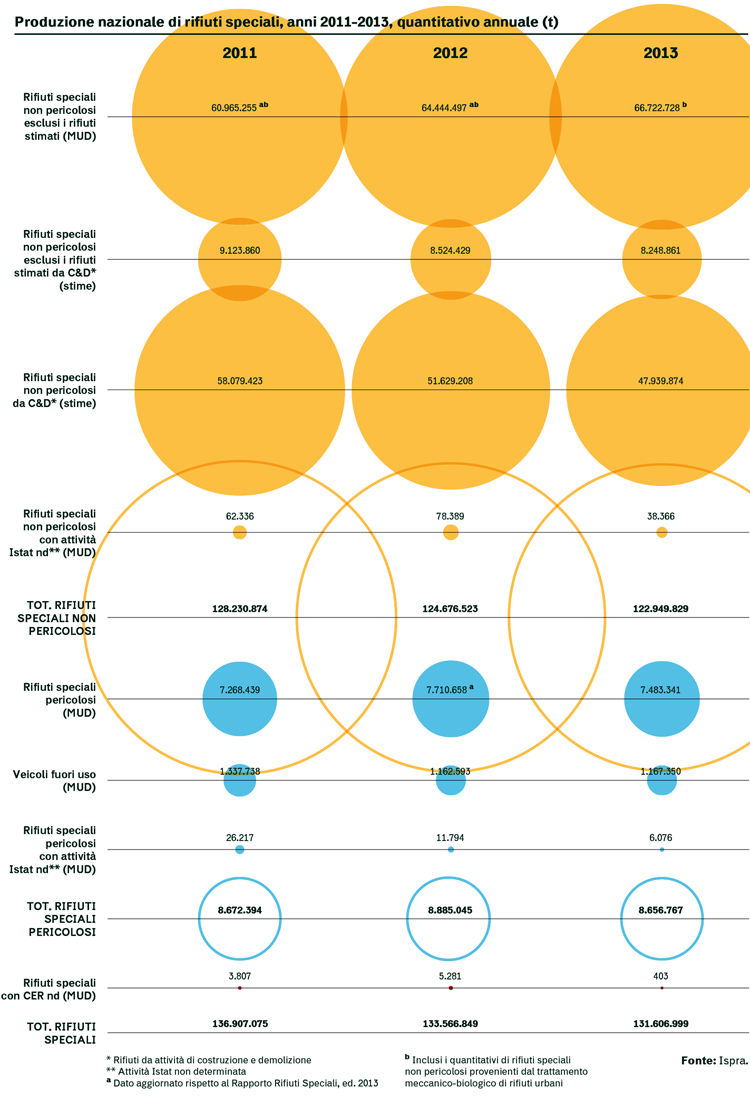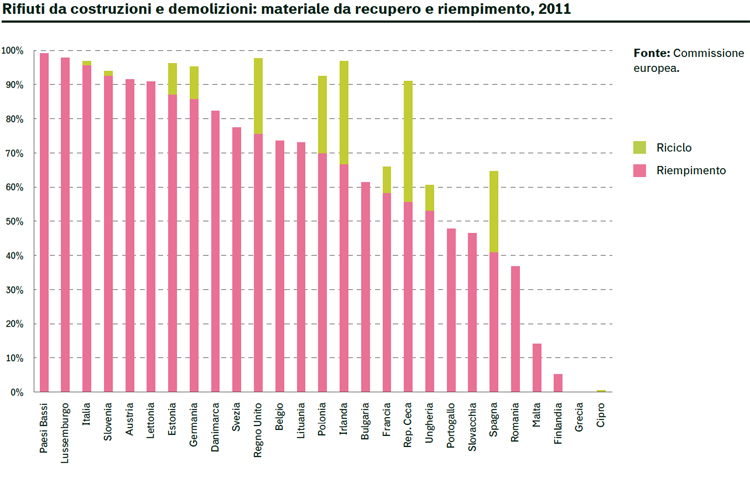According to the calculations of the European Commission each of the 28 member countries produces, on average, a mountain of about 173 million tons of waste from C&D (Construction and Demolition) every year. The vast and sometimes mysterious maze of data analysed by the Commission includes figures ranging from the clearly overestimated (e.g from Malta and Finland) to the significantly understated (e.g Slovenia, Sweden and Ireland). This is further exacerbated by the varying and sometimes inexplicable calculation criteria chosen by individual nations. The data shows that five member States (Germany, UK, France, Italy and Spain) between them account for about 80% of the total C&D waste output produced per year. Specifically, France with more than 231 million tons/year is the main producer of aggregates, closely followed by Germany with 201 million tons/year and the UK with about 100 million tons/year (2012 data). However, these three countries also use recycling regimes, which effectively re-use respectively 63%, 90%, 87% of their C&D waste output. Their recycling example is also followed by Ireland (96%), the Netherlands (95%) and Denmark (86%).
The official estimates of C&D waste output published by Eurostat fail to be compelling and many industry observers and experts are highly critical of the data gathering system which forms the basis of these estimates particularly in connection with reuse and recycling claims. The experts believe that the reality is a far cry from the virtuous picture painted by official estimations sent by individual states to the EU.
This applies equally to Italy notwithstanding the 70% recycling rates claimed by ISPRA (2015), a figure which is actually closer to a paltry 10% according to external independent and accredited bodies such as the Osservatorio Recycle di Legambiente and the National recycled aggregates producers (ANPAR).

There is no doubt that the EU’s C&D waste output represents approximately 50% of the total annual waste output across all categories. Italy’s C&D waste, for example, represents 40% (Ispra, 2015) of the total national annual waste output and is currently regarded as hazardous (requiring specialist treatment) whilst the greater part of it is actually non-hazardous.
In Italy, in 2013 the C&D waste output (including the waste from reclaimed land) was about 2% lower than for the previous year (possibly thanks to the economic crisis) and amounted to approximately 49 million tons. A geographical analysis for that year shows that the North produced nearly 32 million tons, the Centre more than 8.5 million and the South about 8.2 million tons.
It sometimes seems that the EU views the C&D waste and recycling industries in general as the children of a lesser god. Amounting to little more than a single line entry in the wider economic scheme, they are often perceived simply as a landfill dead end. This misses the far-reaching and wider implications of the proper reuse of the waste output as an ideal replacement for more valuable virgin materials as it can serve as a filler for roadbeds, building foundations and as the bedrock of other basic infrastructures as well as an ideal way of reclaiming degraded areas by morphological remodelling.
Further, recycling C&D output requires a much lower calorific value than for example the recycling of plastic, paper or other kinds of waste that are actively encouraged by governments and legislation.
When seen from a chemical and physical viewpoint, C&D waste output is quite variable and diverse as it depends largely on the socio-economic development level at the point of its production and upon the native virgin material on site. Briefly, it can include concrete, cement and various mortars, asphalt, masonry blocks and bricks, stone, earth, wood, metal, plastic, gypsum and other mixed materials.
However, at the outset of the recovery procedure it is simplest to divide the waste output into two broad categories, concrete and rubble. Since waste concrete consists of cement mortar and aggregates obtained originally from quarries it has a much greater value as an aggregate and is much more palatable to the building industry. The rubble, however, tends to be discarded or discounted as it is regarded as too heterogeneous and therefore too complex and costly for treatment and recovery. This inherent difficulty tends to cause rubble to be discounted in favour of concrete waste, as the latter is far easier and more economic to recover and reuse.
As one might imagine, demolition accounts for the greatest proportion, by far, of the waste output from C&D activities. Demolition produces, on average, 1,000-2,000 kg/m², amounting to 93% of total C&D waste production of which 50-100 kg/m² is typically produced by building maintenance activities (i.e. 4.6% of total waste output) and 25-50 kg/m² produced by building construction endeavours (i.e. 2.3% of total waste output). According to figures published by the FIEC (European Construction Industry Federation), about 53% by weight of demolition waste comes from residential or small demolitions, 39% from non-residential sources and 8% from the demolition of entire buildings. It should be possible to ensure an inexhaustible source of recyclable material through the application of simple procedures and precise techniques to the waste output from residential and small-scale sources; in Italy alone these sources generate over 40 million tons/year.
Selective demolition is a recently launched practice in Europe and focuses on the renovation and redevelopment of existing buildings. As such it represents a significant step in the fight against climate change and one that has been officially adopted by Italy complete with a Roadmap that requires an emissions reduction of 80% by 2050 as defined by a recent EU initiative (COP21 Paris). Today, the Italian residential sector accounts for more than a quarter of this targeted reduction unlike areas such as industry or transportation that have, thus far, seen little or no change. In Italy, an estimated 18 million instances per year of deep renovation and radical redevelopments of entire buildings should permanently reduce energy consumption (and therefore reduce emissions) by over 50%. Some EU Member States, such as Germany, have already commenced new initiatives in terms of both energy saving through green building practices and urban regeneration. Germany has developed a comprehensive renewal plan for the refurbishment of 20 million homes to be completed in 20 years through a series of initiatives to achieve energy neutrality by 2050, which includes doubling the rate of deep retrofit of existing buildings to meet a target of 2-4% per annum.
The EU has accelerated the rate of recycling and towards that end established the target of a 70% recovery rate (Directive 2008/98) of inert materials to be achieved by 2020. According to the Commission’s calculations nine countries have already reached the target (Austria, Belgium, Estonia, Germany, Hungary, Luxembourg, Malta and the Netherlands), while another nine, including Italy, still have some work to do. The remaining 10 Member States are a very long way off this target and are unlikely to reach it in the foreseeable future. The process is beset by many delays and difficulties for those countries that have yet to achieve the target. In Italy, for example, much of the difficulty is self-inflicted through the adoption of clumsy efforts to encourage recycling in line with the dictates of “end-of-waste” initiatives as in the case of “earth and rock excavation,” which is subject to continuous and contradictory regulatory modifications that have only served to add confusion and uncertainty and often paradoxical implications.

Among the obstacles in general that have hindered the effective uptake of recycling in this area, in addition to the cumbersome legislation, it is worth mentioning the lack of economic and political planning, the absence of entrepreneurial initiative and the complete lack of systemic controls. Further, the fact that the construction sector has enjoyed (and still enjoys) very low prices for access to raw, virgin materials (with quite negligible royalties paid to the regions) makes the recycling of C&D waste economically unattractive. Furthermore, inert waste is exported from other countries to Italy for environmental restructuring of open cast mines and quarries.
A particularly striking case of this approach is the agreed protocol between the Lombardy Region and Switzerland where building sand from the former is sent in exchange for demolition aggregate waste from the latter, again to fill quarries and other eyesores.
This rather odd situation arises from the lower costs for landfill contributions at EU level. Only seven EU countries apply a tax on inert waste and in these countries the cost of disposal is lower than that for municipal waste in all states with the exception of Denmark. In Italy the cost of disposal of inert waste is fixed at 10 euros per ton, while the European average is about 15 euros per ton. The fact is that two of the Member States with the highest taxes for landfilling of inert waste, Denmark and Netherlands, are also those with the highest recycling rates (Fondazione per lo sviluppo sostenibile, 2015).
An increasing number of industry professionals are taking a much greater interest in the issue of C&D waste output across Europe.
During the Senate hearing held on 23 February 2016, the National Association of Construction Contractors (ANCE) proposed a number of tax incentives and simplifications for the purchase of recycled building materials and for rewarding the development of innovative techniques aimed at selective demolition and facilities based on the use of BIM (Building Information Modelling), which monitors the entire life cycle of buildings.
ANCE has also admitted that the low use of recycled building and demolition waste in Italy is directly connected to the low cost of raw materials, the lack of availability and the persistent mistrust of the industry regarding possible uses of recycled materials. A near perfect synergy.
Second Report of the Osservatorio Recycle di Legambiente, “Recycle. The challenge in the construction industry,” www.legambiente.it/sites/default/files/docs/dossier_recycle_2016.pdf
National Association of recycled aggregates producers, www.anpar.org
European Construction Industry Federation, www.fiec.eu
Directive 2008/98/EC of the European Parliament and of the Council of 19 November 2008 on waste, tinyurl.com/ja4bwqd


